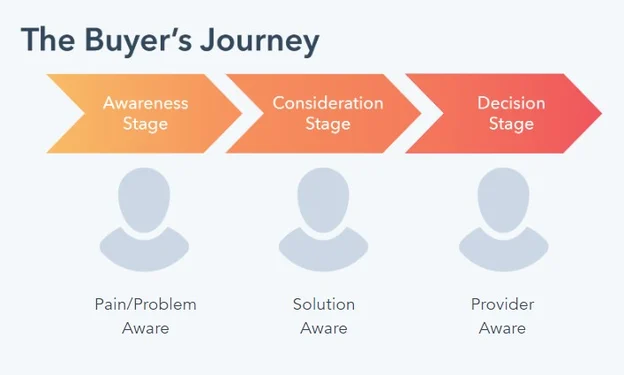All funnels are about the journey the potential customer/user must go through to become a paying customer.
B2B content marketing funnel, in particular, is about serving the right type of content at the right time.
As always though, we need to get started with the basics.
Understanding the B2B Content Marketing Funnel
Before we get into the nitty-gritty, let’s start with the basics of the B2B Content Marketing Funnel, shall we?
What is a B2B Content Marketing Funnel?
In simple terms, the B2B Content Marketing Funnel is a framework that illustrates the customer’s journey with your business.
The funnel is made of 3 stages:
- Awareness (Top of the Funnel)
- Consideration (Middle of the Funnel)
- Conversion (Bottom of the Funnel)
Each stage is different and plays its own role in the customer journey. Therefore, you need to know how they are different, how the content you should be serving should be different at every stage, and how you can make the most out of them all.

Importance of Mapping Content to the Funnel Stages
No one likes being sold things. But everyone loves finding solutions to their problems. So how can a B2B content marketing funnel combine both worlds?
Mapping your content to each stage of the funnel is like having a personalized conversation with your customers. You don’t want to bombard your audience with sales pitches before they even know who you are. Instead, you need to tailor your content to align with each specific stage in the buyer’s journey.
In other words, making a blog post, an infographic, or a demo video is not enough. You also have to know when and how you are going to distribute your content.
Knowing what to say and when to say it to your customers is the backbone of a healthy B2B content marketing funnel strategy.
The Stages of the B2B Content Marketing Funnel
Now it’s a good time to explore the 3 stages of the content marketing funnel one by one.
1. Top of the Funnel (TOFU): Awareness Stage
During the first stage, your goal is this: to create awareness and capture the attention of your audience. During this first stage, your audience might have just stumbled upon your brand. But they haven’t explored it yet.
At the top of the funnel, prospects become aware of their problem and often start looking for solutions. This is what we call Problem Aware. Therefore, your content strategy should focus on providing valuable information and establishing your business as a trusted authority in your industry.
In this stage, you will create content such as blog posts, social media posts, videos, and infographics. But more on that a little later.
2. Middle of the Funnel (MOFU): Consideration Stage
Once prospects are aware of their problem or need, they enter the consideration stage. In this stage, they seek out more information and potential solutions. This is what we call Solution Aware. Now, they are considering whether your products or services can solve their problems.

At this point, you should educate them about your products or services by showcasing their features, benefits, and how they solve specific pain points. Building trust and credibility is crucial in this stage.
Incorporate various content types such as case studies, whitepapers, and webinars to provide detailed insights into what makes your offerings unique.
3. Bottom of the Funnel (BOFU): Conversion Stage
At the bottom of the funnel, your prospects are ready to make a decision. They are considering purchasing your product or taking the desired action, and your content needs to convince them that you’re the best choice. This is what we call Product/Service Aware.
In the decision stage of the B2B content marketing funnel, it’s crucial to convince prospects to choose your business over competitors. To make this happen, you will have to use targeted content that highlights customer testimonials or success stories with measurable results. You can also leverage analytics data from previous customers’ buyer journeys to personalize recommendations based on their specific needs.
Lastly, don’t forget to include compelling call-to-action elements throughout this phase to encourage conversion actions like requesting a demo or signing up for a free trial.
1. Top of the Funnel: Creating Awareness through Content
Now that we’ve covered the basics, let’s delve into the first stage of the funnel: Awareness. This stage is all about making a great first impression; it’s about generating interest and capturing the attention of your target audience.
Therefore, you want to create content that sparks curiosity and encourages prospects to explore further. But first, you need to set up the necessary marketing channels.
Social media marketing allows you to connect with potential customers on platforms they already use daily. Search engine optimization (SEO) ensures that your content is easily discoverable from search engines. And collaborating with influencers who have a strong following in your niche can help amplify your message and increase brand visibility.
Types of Content for Awareness
During the first stage, content needs to be informative, entertaining, and visually appealing. Here are some content types that work wonders at the TOFU:
Social media content: Engage with your audience on social media platforms like Facebook, Twitter, and LinkedIn. Share valuable content, and interact with your followers.
Blog posts & articles: Share valuable insights, industry trends, and problem-solving tips. Blogging is an effective way to showcase your expertise and knowledge.

Infographics: Visualize complex information in a fun and shareable way. Infographics are eye-catching and easy to digest, making them perfect for capturing attention.
Checklists: Checklists serve as a systematic tool to ensure that nothing important is overlooked and underline all the important points and information. They are excellent TOFU content because they are easy to consume, and they are actionable and shareable.
Videos: Steadily and surely, video has become the winning format. Through videos, you can show off your products, tell your brand story, or provide educational content. Video content is highly engaging and can quickly convey your message.
Example of TOFU B2B Content Marketing
Let’s consider an example to see how top-of-the-funnel content marketing works. Imagine you’re the content manager of a SaaS project management tool.
In this stage, you could create blog posts about time management techniques and tips for boosting team productivity. On social media, you could share infographics on the benefits of project management for businesses (e.g. how many hours the company saves with the right time management). Additionally, you could create an introductory video on the homepage of the website that would introduce the tool and its capabilities briefly to the visitor.
Key Metrics for TOFU B2B Content Marketing
Now that have established that every stage of the B2B content marketing funnel means creating different content, it comes as no surprise that every stage also needs to have its own metrics.
Website traffic: Measures the total number of visitors to your website. Use website analytics tools like Google Analytics to track the total number of visitors to your domain.
Pageviews: The breakdown of your website traffic. Monitor the number of pageviews on your blog posts, articles, and other content assets to understand what topics are attracting attention. Google Analytics will also be your friend here.
Social media reach: Track the number of people who see your content on social media platforms. Most social media platforms offer built-in analytics.
Search engine ranking: SEO is your friend. Monitor the ranking of your content for relevant keywords to gauge organic visibility. SEO platforms like Ahrefs or SEMrush will come in handy.
2. Middle of the Funnel: Boosting Consideration through Content
Once you have successfully created awareness of your brand, it’s time to nurture those leads through the consideration stage.
Now, they’ve already shown interest in your brand and are actively seeking more information to help them make a decision. As your prospects move down the funnel, they enter the Consideration stage.
By offering case studies, product demos, and comparisons, you can showcase the unique benefits of your solutions.
Types of Content for Consideration
To nurture leads in this stage, consider using the following types of content:
Whitepapers & eBooks: Offer in-depth guides and case studies that address specific challenges your audience faces. This content demonstrates your thought leadership and expertise
Webinars: Host informative webinars that educate your audience and position your brand as a thought leader. What’s more, webinars allow you to interact with your prospects in real time and answer their questions.
Comparison content: Provide comparisons between your offerings and your competitors, highlighting your unique value. This content helps prospects weigh their options and this is where you need to prove why you are the better choice. Even if you aren’t offering a product, or you aren’t even a SaaS, consider creating comparing listicles .
Demo videos: B2B is usually more complex than B2C. Most consumer goods and services hardly need how-tos and users don’t need to familiarize themselves with them. On the other hand, B2B products and services need some time and space to introduce themselves. Videos are an excellent format because, in a short period of time, a video can demonstrate features, benefits, and use cases. A good demo video simplifies complex concepts through visual learning and it’s engaging and memorable.
Case studies: In-depth analysis in B2B is, yet again, crucial. Case studies provide real-world examples of how a product or service has been successfully applied in a practical setting. When written and presented correctly, a case study has a problem-solving approach, offers data-driven results, and inspires the reader.
Example of MOFU B2B Content Marketing
Let’s go back to our SaaS project management tool example.
In the Consideration stage, you could offer an eBook that dives deep into successful project management case studies, showcasing how your tool has helped businesses achieve their goals. Another MOFU content example is a demo video that you can send through email to anyone who is looking to know more about your tool.
Additionally, you can create landing pages that compare your tool with competitors’ tools, emphasizing its superior features and benefits.
Key Metrics for MOFU B2B Content Marketing
Here are the key metrics you need to track for your MOFU content.
Engagement metrics: These kinds of metrics include metrics such as time on page, bounce rate, and scroll depth to measure how engaged users are with your content. You will find those and other relevant metrics in Google Analytics 4’s Explore section (what used to be Behavior in Universal Analytics).
Lead generation: Monitor the number of leads generated through content downloads, newsletter sign-ups, or contact forms. Use marketing automation platforms like HubSpot, Marketo, or MailChimp to track leads generated through form submissions, email sign-ups, or content downloads.
Email metrics: Measure email open rates, click-through rates, and conversion rates to assess the effectiveness of your email campaigns. All self-respected marketing automation platforms provide these kinds of metrics, and then some.
Form completion rate: Calculate the percentage of visitors who complete forms on your landing pages to access gated content. You will achieve that through your website’s form builder or marketing automation platform.
3. Bottom of the Funnel: Driving Conversions with Conversion Content
Congratulations! We’ve arrived at the most exciting stage of the funnel: Conversion. Driving conversions is the ultimate goal of any B2B content marketing funnel. Your prospects are now ready to make a decision, and your content needs to seal the deal.
At the bottom of the funnel, your content’s goal is to drive conversions and encourage prospects to take action. This is the moment of truth; the movement where your content needs to convince them that your product or service is the best solution to their problem, compared to other solutions.
To achieve this, you need conversion-focused content that addresses their specific pain points and offers a clear solution. Remember to make the process as seamless as possible by including strong calls-to-action throughout your content to guide prospects toward making a purchase decision.
Types of Content for Conversion
To persuade prospects to convert, try these content types:
Product/ service reviews: 94% of consumers say a bad review has convinced them to avoid a business. Reviews are very impactful so you better make them count. What’s more, they offer valuable insights, credibility, engagement, and build trust.
Product overviews: A comprehensive yet concise summary of what your product or service is; what it does, and why it is worth considering. Product overviews are also a valuable tool for your sales team as they the team to quickly convey essential product information to potential buyers.
Product demonstrations and webinars: Give prospects an in-depth look at your offering, allowing them to visualize its benefits and see firsthand how it solves their pain points. This interactive approach helps drive engagement and accelerates the decision-making process.
Free trials and demos: Ofer a risk-free opportunity for prospects to experience your product or service before committing to a purchase. By providing hands-on access, you eliminate doubts and uncertainties while giving them a taste of what they can expect as paying customers.
Example of BOFU B2B Content Marketing
For our SaaS project management tool example, this is the stage to showcase glowing testimonials from happy customers, demonstrating how your project management tool has transformed their businesses.
Offering a free trial or demo of your software can provide prospects with a hands-on experience, showcasing its benefits. Additionally, running a limited-time discount promotion could create urgency and push prospects toward making a purchase decision.
Key Metrics for BOFU B2B Content Marketing
In the BOFU stage, you will need to keep in mind the below metrics.
Conversion rate: Measure the percentage of leads that convert into paying customers or complete the desired action (e.g., product purchase or request for a demo). Set up conversion tracking in Google Analytics or use conversion data from your CRM to calculate the percentage of leads that convert into customers.
Sales-Qualified Leads (SQLs): Track the number of leads that your sales team deems as potential customers based on qualification criteria. Use your CRM system to track leads that meet specific criteria and are deemed qualified for the sales team.
Customer Acquisition Cost (CAC): CAC measures the total cost incurred on acquiring an individual customer over a determined span of time. Calculate CAC by dividing your total marketing and sales expenses by the number of customers acquired over a specific period.

Customer Lifetime Value (CLV): CLV measures the total revenue a company expects from a single customer over a span of time. Calculate CLV by determining the average revenue generated by a customer over their entire relationship with your company.
💡 To learn more about calculating accurately CAC, CLV, and other growth metrics.
Conclusion
And there you have it! This was our full guide to the B2B content marketing funnel.
Whether you’re just starting out or looking to fine-tune your existing B2B content marketing funnel, we’ve got you covered.
And don’t forget, a successful funnel is the kind of funnel that serves the right kind of content at the right time.



